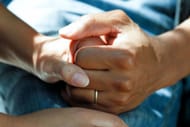Body dysmorphic disorder is a relatively common psychological condition in which a person is overly concerned about a perceived flaw in their physical appearance.
Individuals suffering from body dysmorphic disorder (BDD) may be concerned about any portion of their body, but their hair and face are particularly so. A person may be concerned about having a cheeky grin, irregular lips, or another aspect.
Some people believe their pimples or facial hair are more noticeable and significant than they should be. Others are concerned that their entire appearance is unacceptable.
What exactly is body dysmorphic disorder?

Most people worry about certain aspects of their face or body at some point in their life, but a person with a body dysmorphia may spend long periods fretting about physical details that are barely perceptible to others. This worry can turn into an obsession.
The disorder has less to do with actual physical appearance and more to do with a person's body identity or how they perceive themselves. Many people with body dysmorphia suffer from anxiety, which can have a negative impact on their connections and quality of life.
It doesn't help to reassure a person suffering from BDD that the defect they perceive is not genuine or significant.
Body Dysmorphic Disorder Symptoms
Body dysmorphic disorder symptoms include:
- Concerned about a specific part of the body (particularly your face)
- Spend a lot of time comparing their appearance to other people's
- Spend a lot of time looking at themselves in mirrors or avoid mirrors entirely go to great lengths to conceal flaws. For instance, by spending a long time combing their hair, applying make-up, or choosing clothes to pick at their skin to make it smooth
- BDD can have a significant impact on daily life, including work, social life, and relationships.
This obsession may result in the following behaviors:
- Extreme self-consciousness when it comes to physical appearance, excessively touching
- picking, measuring, or staring at flaws neglecting work, social life, family, health status, and well-being
- Other aspects of life due to pathological obsession with the defect
- Frequently check the features in their reflections
- Introspective doors and other surfaces, avoiding mirrors entirely and removing them from the home to conceal their perceived physical defect, for example, with wigs, clothing, or makeup
Body dysmorphic disorder treatments (BDD)

Body dysmorphic disorder treatments frequently entails a combination of:
Cognitive behavioral therapy (CBT)
CBT can help manage body dysmorphic disorder signs by changing how individuals think and act. It aids in the discovery of what causes the symptoms and teaches new ways of thinking about and dealing with your habits.
Therapists will agree on therapy goals and collaborate to try to achieve them. CBT for body dysmorphic disorders generally include an exposure and reaction prevention technique (ERP). That entails gradually confronting circumstances that would normally cause one to obsess over one's appearance and become anxious.
Selective serotonin reuptake inhibitors (SSRIs)
Antidepressants of this type are known as SSRIs. There are several SSRIs, but fluoxetine is the most frequently used to treat BDD. SSRIs may take up to 12 weeks to have an impact on BDD symptoms.
If they work, people will most likely be asked to continue taking them for several days or weeks to treat the symptoms further and prevent them from recurring. SSRIs typically have side effects, but they usually go away after a few weeks.
Additional treatment

After 12 weeks of treatment with both CBT and an SSRI, people may be prescribed a specific variety of SSRIs or another antidepressant called clomipramine if their BDD symptoms do not improve.
If a person's symptoms do not improve, they're usually referred to a mental health hospital or clinic that specializes in body dysmorphic disorders. These services most likely conduct a more thorough evaluation of the BDD.
They may provide additional CBT or a different form of therapy, as well as various versions of antidepressants.
Conclusion
People suffering from body dysmorphic disorder become obsessed with a perceived flaw or defect in their body.
They may spend an inordinate amount of time attempting to conceal or correct the flaw. Often, these flaws are assumed or so minor that others hardly notice them but not for the person with BDD.
Obsessive thoughts impair a person's ability to function. Speak with your doctor if you or a loved one has a body dysmorphic disorder. Usually, a mixture of therapy and medication can alleviate symptoms and allow the person to resume their normal life.
